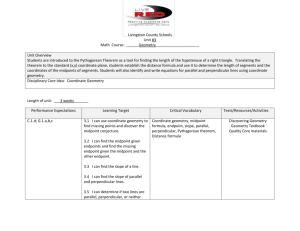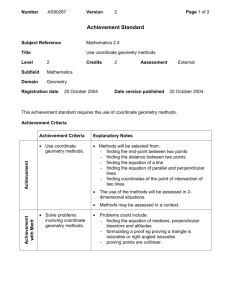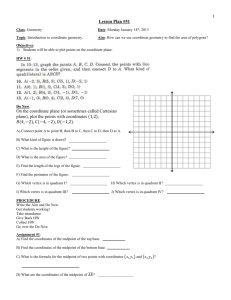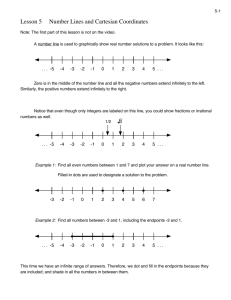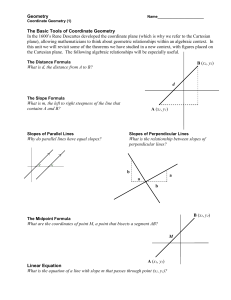1. Simultaneous Equations
advertisement
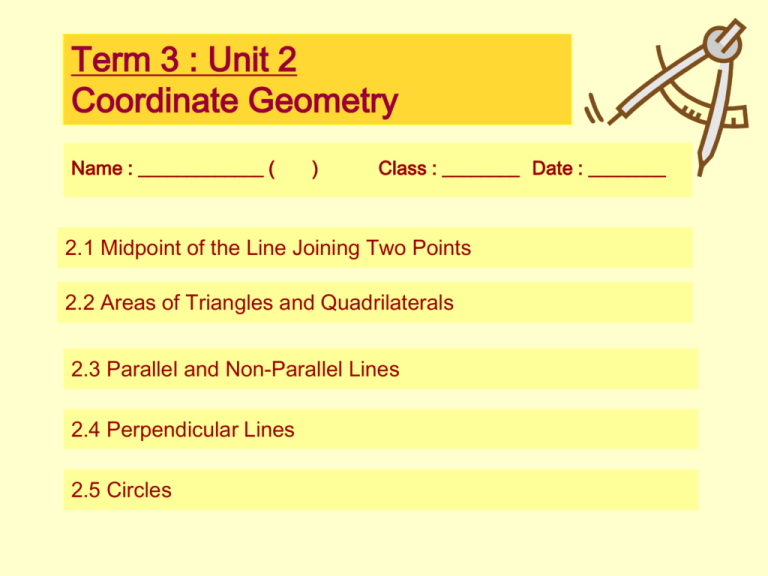
Term 3 : Unit 2 Coordinate Geometry Name : _____________ ( ) Class : ________ Date : ________ 2.1 Midpoint of the Line Joining Two Points 2.2 Areas of Triangles and Quadrilaterals 2.3 Parallel and Non-Parallel Lines 2.4 Perpendicular Lines 2.5 Circles Coordinate Geometry 2.1 Midpoint of the Line Joining Two Points Objectives In this lesson, you will learn how to find the midpoint of a line segment and apply it to solve problems. Coordinate Geometry y A line AB joins points (x1, y1) and (x2, y2). B ( x 2 , y 2) M ( x, y ) A ( x 1 , y 1) M (x, y) is the of AB. of Take midpoint the x-coordinate D and the y-coordinate of Construct E. a right angled triangle ABC. E ( x2 , y) C ( x 2 , y 1) D ( x , y 1) x x1 Ex2is y1 y12 y2 xpoint D is M isx1the and 2 2 , y1 2 , x1 , 2 2 Construct the midpoints D and E of the line segments AC and BC. Take the mean of the coordinates at the endpoints. Coordinate Geometry Example 1 P, Q, R and S are coordinates of a parallelogram and M is the midpoint of PR. Find the coordinates of M and S and show that PQRS is a rhombus. y Q ( 9 , 6) R ( – 2 , 4) 4 2 4 4 M , 1,0 2 2 M is also the midpoint of QS. M M ( 1 , 0) OO P ( 4 , – 4) S ( a– , 7 b ,) – 6 ) x 9a 6b M , 1,0 2 2 a 7, b 6 S = 7, 6 PQ 9 4 6 4 QR 9 2 6 4 125 2 2 2 125 2 PQ QR the parallelogram PQRS is a rhombus Coordinate Geometry Example 2 3 points have coordinates A(–1, 6), B(3, 2) and C(–5, –4). Given that D and E are the midpoints of AB and AC respectively, calculate the midpoint and length of DE. y A ( – 1 , 6) M ( – 1 , 2 E ( – 3 , E1 ) D ( 1 , 4) 1 2 ) B ( 3 , 2) M x C ( – 5 , – 4) 1 3 6 2 D , 1, 4 2 2 1 5 6 4 E , 3,1 2 2 Let M be the midpoint of DE. 1 3 4 1 1 M , 1, 2 2 2 2 DE 3 1 1 4 2 2 5 Coordinate Geometry Example 3 If A(2, 0), B(p, –2), C(–1, 1) and D(3, r) are the vertices of a parallelogram ABCD, calculate the values of p and r. Let M be the midpoint of AC. y 2 1 0 1 1 1 M , 2, 2 2 2 D(3, 3 r )) C ( – 1 , 1) M M ( 1 2 , 1 2 ) A ( 2 , 0) BB(( p – ,2 ,– –2)2) x M is also the midpoint of BD. p 3 2 r 1 1 M , 2, 2 2 2 p 2, r 3 Coordinate Geometry 2.2 Areas of Triangles and Quadrilaterals Objectives In this lesson, you will learn how to find the areas of rectilinear figures given their vertices. Coordinate Geometry Area of Triangles y ABC is a triangle. We will find its area. CC (( 44 ,, 33 )) x Construct points D and E so that ADEC is a trapezium. AA (( –– 22 ,, –– 11 )) D ( – 2 , – 3) BB (( 22 ,, –– 33 )) E ( 4 , – 3) Area of ABC Area of trapezium ADEC Area of ADB Area of BEC 1 1 1 2 6 6 4 2 2 6 2 2 2 24 4 6 14 square units Coordinate Geometry y B ( x 2, y 2 ) ABC is a triangle. The vertices are arranged in Construct points D, E and an anticlockwise F on the x-axis as shown. direction. We will find its area. C ( x 3, y 3 ) A ( x 1, y 1 ) x D ( x 3, 0 ) E ( x 2, 0 ) F ( x 1, 0 ) Area of ABC Area of ABEF Area of BCDE Area of ACDF BE AF EF 12 CD BE DE 12 CD AF DF 12 y2 y1 x1 x2 12 y3 y2 x2 x3 12 y3 y1 x1 x3 1 2 1 2 1 2 x1 y2 x1 y1 x2 y2 x2 y1 x2 y3 x2 y2 x3 y2 x3 y3 x1 y3 x1 y1 x3 y1 x3 y3 x1 y2 x2 y3 x3 y1 x2 y1 x3 y2 x1 y3 Coordinate Geometry y B ( x 2, y 2 ) x1 x2 x3 x1 y1 y2 y3 y1 C ( x 3, y 3 ) A ( x 1, y 1 ) Definition x x1 y2 x2 y3 x3 y1 x2 y1 x3 y2 x1 y3 1 Area of ABC x1 y2 x2 y3 x3 y1 x2 y1 x3 y2 x1 y3 2 From the previous slide, we know that 1 x1 2 y1 x2 x3 x1 y2 y3 y1 Coordinate Geometry Example 4 Find the area of a triangle with vertices A(–2, –1), B(2, –3) and C(4, 3). y C ( 4 , 3) x The vertices A, B and C follow an anticlockwise direction. 1 2 2 Area of ABC 2 1 3 A ( – 2 , – 1) 4 2 3 1 B ( 2 , – 3) 1 6 6 4 2 12 6 2 14 square units Coordinate Geometry Area of Quadrilaterals y Find the area of a quadrilateral with vertices A(x1, y1 ), B(x2, y2 ), C(x3, y3 ) and D(x4, y4 ), following an anticlockwise direction. D ( x4 , y4 ) C ( x3 , y3 ) A ( x1 , y1 ) x Area of ABCD ABC ACD 1 x1 x2 x3 x1 1 x1 x3 x4 x1 2 y1 y2 y3 y1 2 y1 y3 y4 y1 1 Area of ABCD x1 y2 x2 y3 x3 y1 x2 y1 x3 y2 x1 y3 Split the quadrilateral 21 into two triangles. x1 y3 x3 y4 x4 y1 x3 y1 x4 y3 x1 y4 2 1 x1 y2 x2 y3 x3 y4 x4 y1 x2 y1 x3 y2 x4 y3 x1 y4 2 B ( x2 , y2 ) Coordinate Geometry y D ( x4 , y4 ) C ( x3 , y3 ) A ( x1 , y1 ) x The area of a quadrilateral with vertices A(x1, y1 ), B(x2, y2 ), C(x3, y3 ) and D(x4, y4 ), following an anticlockwise direction. B ( x2 , y2 ) 1 x1 y2 x2 y3 x3 y4 x4 y1 x2 y1 x3 y2 x4 y3 x1 y4 2 1 x1 2 y1 x2 x3 x4 x1 y2 y3 y4 y1 The method for finding the area of quadrilaterals is very similar to that of triangles. Coordinate Geometry Example 5 y Q ( – 4 , 3 ) Find the area of a quadrilateral with vertices P(1, 4 ), Q(–4, 3), R(1, –2) and S(4, 0), following an anticlockwise direction. P ( 1 , 4 ) x S ( 4 , 0 ) R ( 1 , – 2 ) 1 1 Area 2 4 4 1 4 1 3 2 0 4 1 3 8 0 16 16 3 8 0 2 24 square units Coordinate Geometry 3.3 Parallel and Non-Parallel Lines Objectives In this lesson, you will learn how to apply the conditions for the gradients of parallel lines to solve problems. Coordinate Geometry yy yy == mm 1 1xx ++ cc 1 1 1 1 Consider the straight line with equation y = m1 x + c1 that makes an angle of θ1 with the positive x-axis. yy == mm 2 2xx ++ cc 2 2 Translate the line parallel to the x-axis. 2 2 xx OO The new line has equation y = m2 x + c2 and makes an angle of θ2 with the positive x-axis. The lines are parallel to each other. The lines make the same angle with the x-axis. θ1 = θ2 The lines have the same gradient. m1 = m2 Coordinate Geometry Example 6(a) The diagram shows a parallelogram ABCD with A and C on the x-axis and y-axis respectively. The equation of AB is x + y = 2 and the equation of BC is 2y = x + 10. y C 2 y = x + 10 B x + y = 2 D A O At A, y 0. x (a) Find the coordinates of A, B and C. At B, x y 2 2 y x 10 Since x y 2, x 2. Solving x 2, y 4. A is 2, 0 B is 2, 4 . At C , x 0. Since 2y x 10, y 5. C is 0,5 . Coordinate Geometry Example 6(b) The diagram shows a parallelogram ABCD with A and C on the x-axis and y-axis respectively. The equation of AB is x + y = 2 and the equation of BC is 2y = x + 10. y C (0,5) 2 y = x + 10 B x + y = 5 x + y = 2 2y = x – 2 D A O (2,0) x (b) Find the equations of AD and CD. AD is parallel to BC (2y = x + 10). CD is parallel to AB (x + y = 2 ). Gradient of AD = gradient of BC = 0.5 Gradient of CD = gradient of AB = –1 y0 1 Equation of AD is x2 2 2y x 2 Since A is (2, 0) Equation of AD is Since C is (0, 5) y 5 1 x0 x y 5 Coordinate Geometry Example 7 Find the equation of the line which passes through the point (–2, 3) and is parallel to the line 2x + 3y – 3 = 0. 2x 3 y 3 0 3 y 2 x 3 y 23 x 1 m in y = mx Rearrange in + thec is the form y =gradient mx + c. of the line. The gradient of the line is 23 . The line through 2,3 with gradient 23 is y ( – 2, 3) 2x + 3y – 5 = 0 2x + 3y – 3 = 0 O y 3 2 x 2 3 3 y 3 2 x 2 3 y 9 2 x 4 The equation of the line is 2 x 3 y 5 0. x Coordinate Geometry 2.4 Perpendicular Lines Objectives In this lesson, you will learn how to apply the conditions for the gradients of perpendicular lines to solve problems. Coordinate Geometry Consider the straight line with equation y = m1 x + c1 that makes an angle of θ1 with the positive x-axis. y y = m 1x + c 1 Rotate the line clockwise through 90°. A y = m 2x + c 2 1 O B 2 D x C AD AC m1 tan 1 BD AB AC AB m1 m 2 1 AB AC The new line has equation y = m2 x + c2 and makes an angle of θ2 with the negative x-axis. m2 AD AB tan 2 DC AC 1 m2 m1 Applies to any two perpendicular lines. Coordinate Geometry Example 8 y B ( 4 , 15 ) Two points have coordinates A(–2, 3) and B(4, 15). Find the equation of the perpendicular bisector of AB. Hence calculate the coordinates of the point P on the line 3y = x + 1 if P is equidistant from A and B. M ( 1, 9) 2 y = – x + 19 A( – 2, 3) 3y = x + 1 O P ( 11 , 4 ) x 2 4 3 15 The midpoint of AB is M . , 1,9 2 2 15 3 Gradient of AB 2 4 2 Gradient of perpendicular bisector = 12 Equation of perpendicular bisector is y 9 12 x 1 2 y x 19 Find P. 2 y x 19 3y x 1 5 y 20 12 x 1 P 11, 4 Solve Adding Substitute simultaneou forthe y s equations equations y4 x 11 Coordinate Geometry Example 9 y The points A and B have coordinates (5, 2) and (3, 6) respectively. P and Q are points on the x-axis and y-axis and both P and Q are equidistant from A and B. B( 3, 6) 2y = x + 4 M ( 4, 4) (a) Find the equation of the perpendicular bisector of AB. Q ( 0, 2) A( 5, 2) P 35 6 2 The midpoint of AB is M . , 4, 4 2 2 62 (b) Find the coordinates of P and Q. Gradient of AB 2 35 At P y 0, 2 y x 4 Gradient of perpendicular bisector = 12 x 4 P 4, 0 Equation of perpendicular bisector is ( – 4, 0) O x y 4 12 x 4 2y x 4 At Q x 0, 2 y x 4 y2 Q 0, 2 Curves and Circles 2.5 Circles Objectives In this lesson, you will learn to • recognise the equation of a circle, • find the centre and radius of a circle, • find the intersection of a circle and a straight line. Curves and Circles y Consider the point C(a, b) and a point P(x, y). P (x,y) The distance between C and P is x O The equation of the circle is x a y b 2 PC C (a,b) 2 The locus of P as the line rotates around C is a circle of radius r. x a y b 2 2 r2 Curves and Circles y The circle with centre C(a, b) and radius r has equation P (x,y) x a y b 2 r 2 r2 x 2 2ax a 2 y 2 2by b2 r 2 C (a,b) x 2 y 2 2ax 2by a 2 b2 r 2 0 The general form of the equation is x x 2 y 2 2 gx 2 fy c 0 O g a, f b c a b r 2 2 2 centre C g , f radius f 2 g2 c Curves and Circles Example 10 Find the equation of the circle whose centre is C(–3, 4) and which touches the x–axis. y The radius of the circle is 4 units. C ( – 3, 4) The equation of the circle is: x 3 y 4 2 2 4 4 2 x O x 2 6 x 9 y 2 8 y 16 16 x2 y 2 6x 8 y 9 0 The radius is the ycoordinate of C. Curves and Circles Example 11 Find the coordinates of the points of intersection of the line 2y + x = 12 with the circle x2 + y2 – 6x – 4y – 12 = 0. y x 2 2 + y – 6 x – 4 y – 12 = 0 5 2 y x 12 x 12 2 y Substitute for x into the circle equation. 2 y + x = 12 x y 6 x 4 y 12 0 2 12 2 y 2 2 5 10 y 2 6 12 2 y 4 y 12 0 144 48 y 4 y 2 y 2 72 12 y 4 y 12 0 5 y 2 40 y 60 0 5 y 2 y 6 0 y2 or y6 x 8 or x0 Using x = 12 – 2y. The points are 8, 2 and 0, 6 x Curves and Circles Example 12 (a) Give the equation of the circle with centre C(–2, 0) and radius r = 3. The equation is 2 x 2 y 0 3 2 2 x2 4x 4 y 2 9 x2 y 2 4 x 5 0 (b) Find the coordinates of the centre and the radius of the circle x2 + y2 – 2x – 6y + 1 = 0. x 2 y 2 2 gx 2 fy c 0 2 g 2, g 1 2 f 6, f 3 c 1 centre C g , f 1,3 radius 3 3 1 1 2 2

